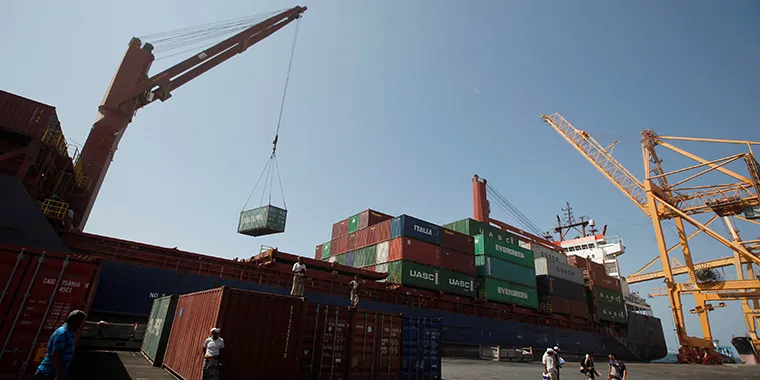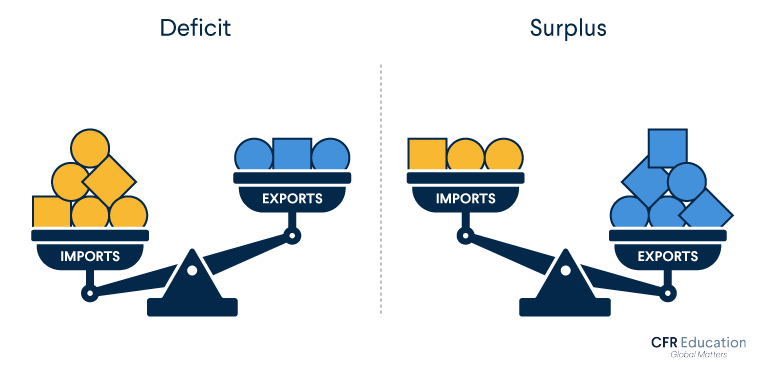What a Trade Deficit Means
What is a trade deficit? And, perhaps more important, what is it not?
Some policymakers have prioritized reducing the U.S. trade deficit, arguing that Americans are losing on trade, and pointing to the deficit as evidence. But economists disagree on whether it actually needs to be reduced—and if so, why.
What most experts do agree on, though, is that a trade deficit (or a trade surplus) in itself is neither a good nor a bad thing.
It tells you more about how a country’s economy operates and what it prioritizes than how well or poorly a country’s economy is doing.
Why?
Because trade is not a zero-sum game: you are not losing if you are importing and winning if you are exporting. Exports are not good and imports are not bad. Trade is much more nuanced than that.
WHAT IS A TRADE DEFICIT?
A country’s total trade is measured by the sum of its imports (products it buys from other countries) and its exports (products it sells to other countries). Countries trade both goods (such as T-shirts or iPhones) and services (such as jobs and education).
This is the breakdown of U.S. imports and exports of manufactured goods and services with its top trading partners in 2018:
| United States and | China | Canada | Mexico | Japan | Germany |
| Total Trade | $739 billion | $721 billion | $678 billion | $300 billion | $251 billion |
| Imports | $559 billion | $360 billion | $378 billion | $179 billion | $159 billion |
| Exports | $180 billion | $361 billion | $300 billion | $121 billion | $92 billion |
When a country imports more than it exports, it runs a trade deficit. A country that does the reverse—exports more than it imports—runs a trade surplus. The United States has bilateral trade deficits with some trade partners and surpluses with others, but overall, it has a trade deficit of $678.7 billion in 2020.
DIFFERENT DEFICITS
Understanding what a trade deficit means starts with acknowledging that there are different types of trade deficits. Bilateral trade deficits (between two countries) have different causes and implications than overall trade deficits (between one country and the rest of the world).
Bilateral trade deficits normally occur because countries have certain comparative advantages.
With a large skilled labor force and advanced technology, the United States efficiently produces many services other countries need, such as business services, and that is evident in the trade balance. The United States actually had a $237 billion surplus in services in 2020 (its goods deficit is what pulls the whole balance into a deficit).
Trade policies often have little effect on bilateral trade balances. For example, the United States has identical trade policies with Germany and the Netherlands because both countries are members of the European Union, which negotiates trade deals as a bloc. But it has a deficit with Germany, and a surplus with the Netherlands. That is not because Germany is cheating the United States, or the United States is cheating the Netherlands. It is about meeting needs. Americans want German cars and machinery, while the Dutch want American medical equipment and pharmaceuticals. All parties benefit from these transactions, not just the exporters.
Bilateral trade deficits are different from overall trade deficits. With overall trade deficits, macroeconomics comes into play. Many economists believe the United States will and should always run an overall trade deficit, because the U.S. dollar is the de facto global currency. Since the dollar is used by so many countries for so many different purposes (for example, the majority of oil is priced and sold in dollars), transactions that take place well outside of the scope of U.S. trade can strengthen the value of the dollar.
The strength of a country’s currency matters, because it affects the relative price of its goods. Since the dollar is valuable, U.S. goods tend to be more expensive than those of other countries. The United States also exports services and technology, which require certain skills and knowledge to produce. They cannot simply be replicated anywhere. Conversely, the United States often cannot compete in manufacturing, because goods from other countries are often cheaper.
To make this clearer, look at the United States’ biggest trade deficit, the one with China.
China structures its economy differently from the United States; it has built up its exporting sector and runs a trade surplus with the world. In 2019, Americans bought $472 billion worth of stuff—both goods and services—from China.
THE FLIP SIDE OF A TRADE DEFICIT
The $472 billion the United States puts into the Chinese economy does not go into a vacuum. China wants something to happen with those dollars; otherwise the influx of U.S. currency would make the Chinese currency, the yuan, more expensive.
China has structured its economy around exports. If its currency becomes more expensive, its goods become more expensive, and therefore less attractive to other countries.
So what are China’s options if it wants to keep selling to the United States (its top market) but not increase the value of the yuan? One is to put those dollars back into the United States. China does this by investing in U.S. businesses, purchasing U.S. real estate, and buying U.S. treasury bonds. So a trade deficit is not a net negative for the United States: in exchange for dollars, Americans receive valuable goods, plus foreign investment.
WHEN ARE TRADE DEFICITS A PROBLEM?
When trade deficits are unsustainable
Some economists warn against having a trade deficit as large as the United States does, because the United States’ ability to sustain it depends on other countries wanting dollars. Because the United States spends more on imports than it earns from exports, it needs to borrow from the rest of the world to make up the difference.
This works, because Americans can rely on foreign investments and foreign borrowing. (Smaller countries with less valuable currencies and fewer investment opportunities cannot support trade deficits.) There is always high demand for the U.S. dollar, and it is seen as a safe bet, meaning other countries are willing to buy U.S. treasury bonds, or other forms of U.S. debt. If the value of the dollar changes, the way the United States operates would have to fundamentally change.
When trade deficits result from unfair practices
Trade between countries ebbs and flows based on “natural” factors such as changing consumer preferences and evolving comparative advantages. But sometimes countries enact tariff or nontariff barriers to gain an advantage in a trade relationship. The bilateral U.S.-China trade balance, for example, has been criticized on the grounds that it stems from China cheating at trade. Over the years, the U.S. government has denounced the Chinese government for erecting tariff and nontariff barriers, manipulating its currency, and providing companies government subsidies, all of which, the U.S. government claims, give China an edge and contribute to a U.S. deficit and Chinese surplus.
But conflating problematic Chinese trade practices with the U.S.-China trade deficit, and especially with the overall U.S. trade deficit, misses the mark. For one thing, it muddies the solutions: reducing the trade deficit is not the same thing as addressing Chinese trade practices. The deficit could decrease without those practices being resolved; likewise, it could increase if they were resolved. Successful U.S. trade policies should target Chinese economic and trade practices, not the deficit.
Many economists are also unconvinced that drastically reducing the deficit should be a goal. A trade deficit can be a sign of a strong economy: Americans are spending dollars on imports, driving demand for goods and services around the world. The deficit represents how the U.S. economy helps stabilize the global economy, a role that yields benefits for the United States and the rest of the world.




